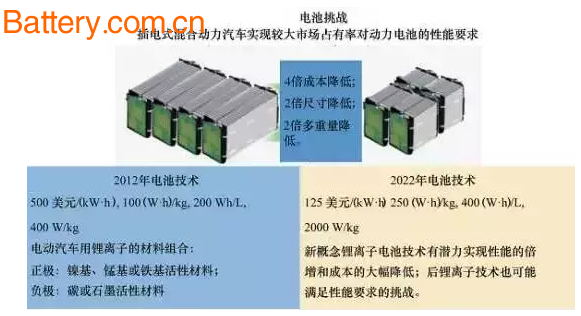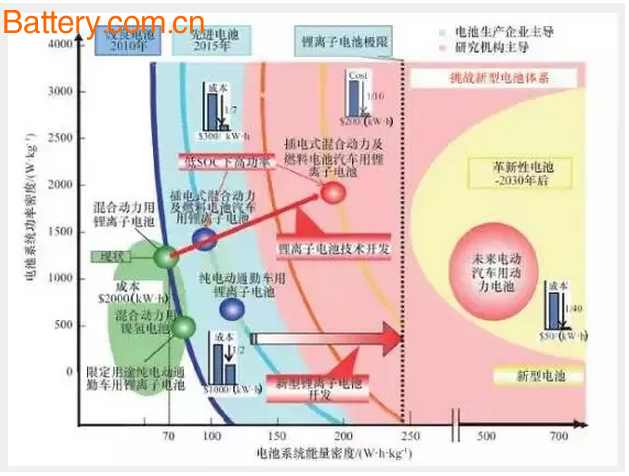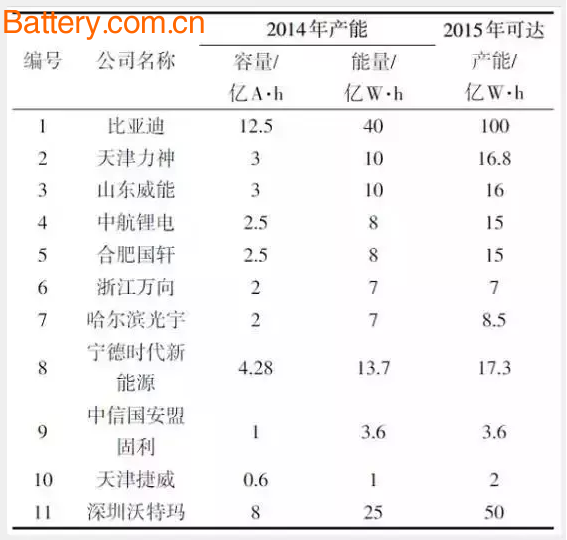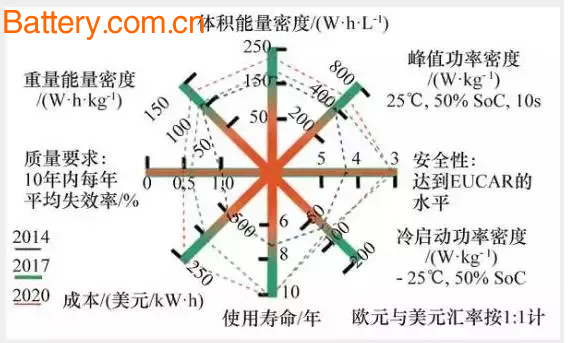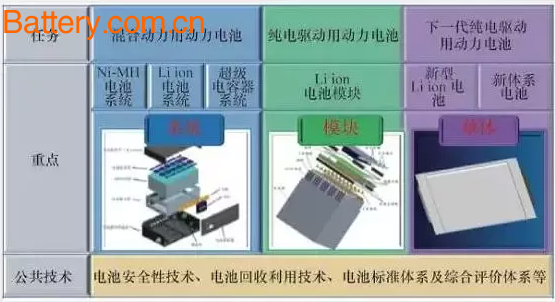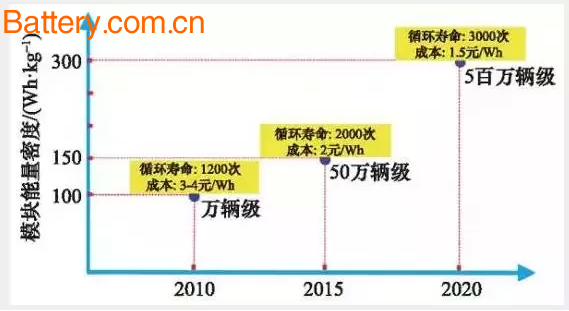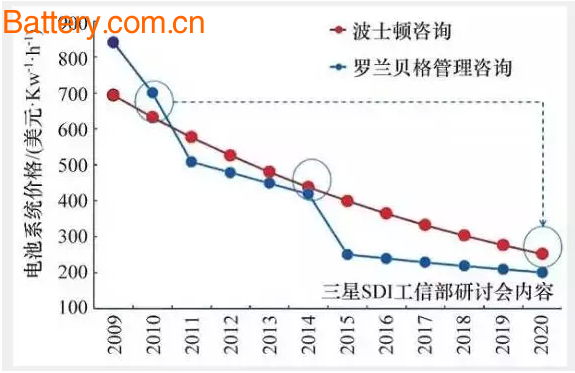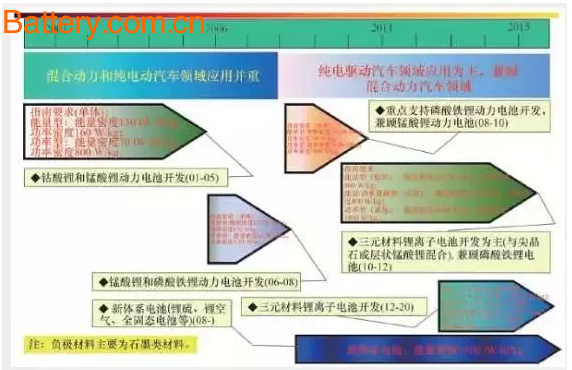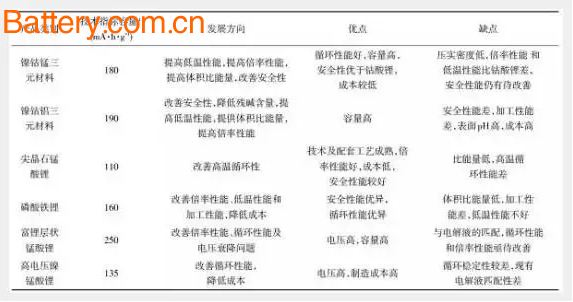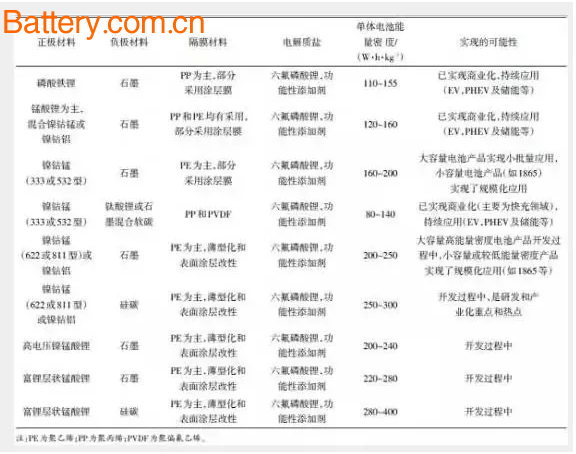The US Department of Energy's Office of Energy Efficiency and Renewable Energy has released the “Electric Vehicles Everywhere Challengeâ€, focusing on the development of lithium-ion battery technology for plug-in hybrid vehicles . National level power battery development plan 1.1 US Power Battery National Regulations The US Department of Energy's Office of Energy Efficiency and Renewable Energy has released the “Electric Vehicles Everywhere Challenge†(Figure 1), with a focus on supporting the development of “lithium-ion battery†technology for plug-in hybrid vehicles. Figure 1 Power Battery System Specifications for the “Electric Vehicles Everywhere Big Challenge†setting 1.2 Japan Power Battery National Regulations The report of the Ministry of Economy, Trade and Industry of Japan proposed the target values ​​of power density, energy density and cost of the vehicle power battery (Fig. 2). Figure 2 Target values ​​of power battery system related parameters set by the Ministry of Economy, Trade and Industry of Japan Then, the New Energy and Industrial Technology Development Organization under the Ministry of Economy, Trade and Industry of Japan released the secondary battery technology roadmap 2013 in 2013, and proposed a more detailed technical specification for electric vehicles and stationary secondary batteries ( Table 1). Table 1 Main technical indicators of Japanese vehicle power battery 1.3 German power battery national regulations Germany has developed a national electric drive platform program to promote the production capacity of single-cell batteries and battery systems in the field of power batteries through the battery beacon research and development project, and proposed the main performance parameters of the power battery system (2014-2020) (Figure 3). Figure 3 Technical specifications of the power battery system set up by the German electric drive platform 1.4 Korean Power Battery National Regulations The world's premier materials project supported by the Ministry of Knowledge Economy of Korea involves two major applications of pure electric vehicles and energy storage. Leading the secondary battery technology research and development project of the green society, including the key materials of lithium-ion battery, application technology research (for energy storage and pure electric vehicles), evaluation and test infrastructure, next-generation battery research - 2020 battery plan 4 sub-projects In order to build a complete power battery industry chain in Korea. 1.5 China Power Battery National Regulations The Ministry of Science and Technology released the 12th Five-Year Plan for Electric Vehicle Major Project (2011-2015) (Figure 4). Figure 4 China's Ministry of Science and Technology electric vehicle major project power battery research and development layout The National Plan for Energy Conservation and New Energy Vehicles issued by the State Council (2012-2020) focuses on the industrialization of power batteries and the standardization of battery modules (Figure 5). In the 13th Five-Year Plan of the country, a special research and development project for new energy vehicles (2016-2020) was established to support the research and development of high-performance power batteries. Figure 5 Related parameters of power battery modules for China's energy-saving and new energy vehicle planning Overview of the development of power battery industry At present, there are three concentrated areas for the development and industrialization of power batteries around the world, located in East Asia where Germany, the United States, and China, Japan and Korea are located. With the expansion of power battery capacity, the price of power batteries will show a rapid decline (Figure 6). Figure 6 Trends in global power battery system prices Overview of international power battery development Table 2 shows information on power battery products produced by international mainstream battery companies. Table 2 Information on power battery products produced by international mainstream battery companies In general, from the field of pure electric drive vehicles, the energy density of large-capacity power battery products produced by foreign power battery companies is mostly 110~180 (W·h)/kg; the energy of small-capacity power battery products. Density 230~250(W·h)/kg; fast-charged lithium-ion power battery is represented by lithium titanate battery, and the energy density reaches 89 (W·h)/kg. China Power Battery Development Overview Through the strong support of the three five-year plans, the choice of material systems for power batteries is diversified, and the trend is shown in Figure 7. Figure 7 Trends in the diversification of China's power battery technology route At present, a complete lithium ion power battery industry chain system has been formed, and the formulation design, structural design and manufacturing process technology of the power battery have been mastered, and the production line has gradually transitioned from semi-automatic pilot to fully automated large-scale manufacturing technology. At present, China has formed four major power battery industrialization areas, mainly in the Pearl River Delta, the Yangtze River Delta, the Central Plains, and the Beijing-Tianjin region. The capacity statistics of China's mainstream power battery companies are shown in Table 3. Table 3 Capacity statistics of China's mainstream power battery companies Future development trend of China's power battery industry (until 2020) Cathode material: The comprehensive performance of the cathode material is shown in Table 4. It is mainly composed of a lithium manganate spinel type material, a layered material represented by nickel-cobalt-manganese, nickel-cobalt-aluminum, and an olivine-type structural material represented by lithium iron phosphate. Table 4 Comparison of comprehensive performance of cathode materials Anode material: The comprehensive performance of the cathode material is shown in Table 5. Graphite materials are still the mainstream of choice. Alloys (such as silicon carbon) and lithium titanate materials are also the focus of industrialization and application for a while and for some time to come. Table 5 Comparison of comprehensive performance of anode materials Diaphragm material: Polyolefin material is the mainstream choice, including polypropylene and polyethylene products, mainly single-layer film and composite film. At the same time, the technology for modifying the surface of the separator material is developed. Electrolyte: Lithium hexafluorophosphate is still the mainstream product in the market. At the same time, some new lithium salts have appeared on the market and have been initially applied (such as lithium bisfluorosulfonimide). The material system and the technical specifications of the single cell that the power battery is expected to achieve in 2020 are shown in Table 6. Table 6 Material system and single battery technical indicators for the expected industrialization of power batteries (2020) China's power battery industrialization development problems 1) The gap between equipment and materials and foreign countries. The industrial chain has begun to take shape, but the structure is still not perfect, and some core equipment and raw materials are still completely dependent on imports. 2) The gap between power battery system integration technology and practical use. Lack of mechanical, electrical and thermal integration of lithium-ion battery system design advantages, as well as in-depth battery management system and electronic control technology research and development capabilities. 3) The strength and depth of the evaluation of the power battery system is not enough. There is still a great lack of assessment and integrity. The demonstration operation has replaced the bench test and vehicle test for some power battery systems. 4) Competition in the power battery market has intensified. in conclusion In recent years, power batteries have developed rapidly in industrialization, which has strongly supported the development of the electric vehicle industry. The new lithium-ion battery and related materials technology has received a lot of attention, and it is expected that the related technologies will make great progress and achieve scale application. With the rapid development of electric vehicles, the power battery will usher in a golden period of explosive growth. Crystal Candle Holders,Brass Candle Holders,Candle Holder Sets,Glass Candle Holder Shijiazhuang Tabo Candles Sales Co., Ltd. , https://www.tbcandlesgift.com